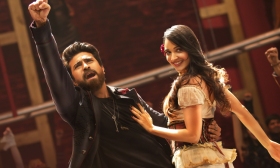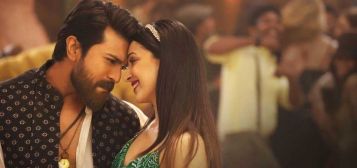
A movie starring both Mega Star Chiranjeevi and Mega Power Star Ram Charan was always going to be a ‘must watch’ film with the question being would it be as good as anticipated. The answer to that question is ‘sort of’ as Koratala Siva at least partially delivers with plenty of action and dancing featuring the two Mega Stars. But the story is less successful, following a predictable and rather pedestrian path. I still enjoyed the spectacle of father and son together on screen and with good choreography for both the songs and the action sequences, there is enough here to make Acharya a worthwhile trip to the cinema.




The film opens with a fairly long animated sequence explaining the history behind the twin villages of Dharmasthali and Padaghattam. At least I think that was what was happening, because the subtitles were difficult to follow and mostly didn’t make sense. But from what I could gather, the village of Dharmasthali developed after the goddess Gattamma came to Earth to defend the tribal people of Padaghattam. The villagers built a temple in her honour and continued to live a peaceful existence until the people of Dharmasthali became corrupted. In contrast the tribal village of Padaghattam still followed the traditional way of life, and still do today, producing ayurvedic medicines that they take across the river to Dharmasthali. However life is becoming more difficult for them as Dharmasthali becomes a hotbed of crime and violence and the goddess seems to be allowing her people to be attacked.
Excitingly for me, CinemaChaat favourite Ajay is playing the role of Vedanna, the leader of the Padaghattam people. Their belief in Dharma means that they are peaceful and won’t fight back when threatened, leaving them vulnerable to the corrupting influence of local bigwig Basava (Sonu Sood). I really enjoyed seeing Ajay in this more pacific role where he gets the chance to emote, conveying emotion using just his eyes and facial expressions instead of just being thug #1. I thought he was excellent here and kept smiling ecery time he appeared onscreen.


Basava is working with businessman and developer Rathod (Jisshu Sengupta) to mine the mineral resources of the region, mainly located in the virgin forest of Siddhavana. Rathod is vicious and nasty for no apparent reason, but Koratala Siva does at least give Basava a sort-of back story that involves a bad hairstyle and humiliation by the people of Padaghattam. He’s also a generally nasty character who enjoys inflicting terror and controlling everyone else around him. Basava has risen up to become the municipal chariman, which gives him control of Dharmasthali, although he still has a bad hairstyle which demonstrates that money isn’t everything as it hasn’t allowed him to find a better hairdresser.



Against the heightening tension between the temple and Basava’s thugs, a stranger arrives in town and sets up a carpenter business in Dharmasthali. Acharya (Chiranjeevi) at first seems to be a do-gooder who sets out to help the people affected by Basava’s greed, but it becomes clear that there is a deeper reason for his involvement. The second half reveals the story of Siddha (Ram Charan) and why Acharya is working to save the people of Padaghattam and Dharmasthali.




It’s a fairly standard story for SI cinema and Kortala Siva doesn’t add anything new to the tale. The hero arrives, the bad guy’s motivations are explained, and then they fight. Mix in a lot of discussion of Dharma, a dash of Temple festivals, Ayurvedic medicine and Naxalite freedom fighters and there you have it. The first half has gorgeous sets from production designer Suresh Selvarajan and cinematographer S Thirumavukkarasu makes the most of the sumptuous colours and beautiful scenery. I loved the first song Laahe Laahe, featuring the stunning Sangeetha Krish, which bursts with colour and energy against the backdrop of the temple. And of course, add in Chiru dancing and it’s a total winner!
Siddha turns out to be the son of a Naxalite leader who was raised by the people of Padaghattam after his parents were killed. Acharya was tasked by Siddha’s father to raise his son in the movement and when Siddha is injured fighting against corruption in Dharmasthala it’s the perfect opportunity for him to go back to his roots. Ram Charan is excellent and his eyes are brilliantly expressive as he shows Siddha to be a true follower of Dharma. There are so many emotions conveyed between Siddha and Acharya just using their eyes that there is an entire section of the film that just focuses on their eyes for a good few minutes. I was in heaven! Although the story may be not be anything new, the interactions between Ram Charan and Chiranjeevi continually made me smile and lifted the energy of the film.



The scenes where Ram Charan is dancing with Chiranjeevi are spectacular and feature plenty of Mega Star patented moves that Ram Charan performs under the approving eye of his dad. It’s really effective and I wanted to see more! The action sequences too are mostly well choreographed, apart from the finale which doesn’t work as well as the earlier pieces. In terms of spectacle and production, the film looks amazing and each set is obviously well designed and beautifully filmed. But essentially the film lacks depth. The reason for Acharya to be in Dharmasthala is revealed too late and so Chiranjeevi’s character lacks motivation for most of the first half. The second half is better and benefits from the interplay between Ram Charan and Chiru, but the finale could have been so much more if Kortala Siva had taken better care of his characters and thought more about Acharya’s motivation.
Seasoned actors Nassar, Tanikella Bharani, Ravi Prakash and Vennela Kishore also put in an appearance and are all excellent in the type of roles they have played many, many times before. I’m not sure why Rathod’s main henchman Khilla (Shatru) had to have a deformity, but the bad guys are mostly faceless and evil because that’s what bad guys just are. Sonu Sood does his usual villain schtick effectively despite limited screentime and those dreadful wigs. But poor Pooja Hegde. After Beast I was hoping she would have a bigger role here, but she has even less to do here. Her character is mostly used as the reason for Acharya to explain Siddha’s history and apart from a song and a brief romance she barely appears in the film.



I did enjoy Acharya and loved watching Ram Charan and Chiranjeevi together on screen. It’s unfortunate that the story doesn’t deliver the same emotional impact, but the songs from Mani Sharma are good, the action well choreographed and the dancing awesome! The worst part of the film is the subtitles which appeared to have been translated literally, and then misspelled (golry instead of glory, their instead of there – seriously did no-one check?) so that I was actually better trying to decipher the Telugu from my very limited vocabulary rather than rely on the subs. For a film with otherwise high production values, it seems such a shame to be let down so badly internationally for something like bad subtitles. So is Acharya worth watching – absolutely! Sit back, enjoy the performances and revel in the pairing of Mega Star Chiranjeevi and Mega Power Star Ram Charan.








































